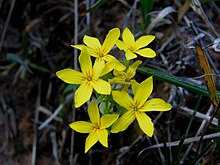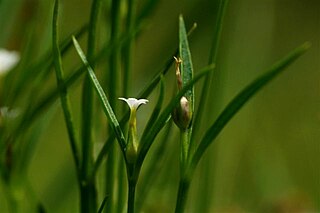| Sebaea | |
|---|---|
 | |
| Sabaea exacoides | |
| Scientific classification | |
| Kingdom: | Plantae |
| Clade: | Tracheophytes |
| Clade: | Angiosperms |
| Clade: | Eudicots |
| Clade: | Asterids |
| Order: | Gentianales |
| Family: | Gentianaceae |
| Tribe: | Exaceae |
| Genus: | Sebaea Sol. ex R.Br. |
| Species | |
See text | |
Sebaea is a genus of annual plants in the family Gentianaceae. [1] Species occur in Africa, Madagascar, India, China, Thailand, Australia and New Zealand. [1] [2] The genus was paraphyletic and has been split in four genera: Exochaenium , Klackenbergia , Lagenias and Sebaeas.str.. [1] [3] [4] Synapomorphies for Sebaea s.str. include the presence of extra stigma along the style [5] (called diplostigmaty [6] [7] ) and the shape of the testa cells of the seeds. [1]
The name honors Albertus Seba (1665–1736), a Dutch pharmacist, zoologist and collector. [8]
Species include (non exhaustive list):
- Sebaea albens (L. f.) Roem. & Schult.
- Sebaea albidiflora F.Muell. - white sebaea [8]
- Sebaea ambigua Cham.
- Sebaea amicorum I.M. Oliv. & Beyers [9]
- Sebaea aurea (L. f.) Roem. & Schult.
- Sebaea bojeri Griseb.
- Sebaea brachyphylla Griseb.
- Sebaea capitata Cham. & Schlechtdl.
- var. capitata Cham. & Schlechtdl.
- var. sclerosepala (Schinz) Marais
- Sebaea chironioides Gilg
- Sebaea elongata E. Mey.
- Sebaea erosa Schinz
- Sebaea exacoides (L.) Schinz
- Sebaea exigua (Oliv.) Schinz
- Sebaea filiformis Schinz
- Sebaea fourcadei Marais
- Sebaea grisebachiana Schinz
- Sebaea hymenosepala Gilg
- Sebaea junodii Schinz
- Sebaea laxa N.E.Br.
- Sebaea leiostyla Gilg
- Sebaea longicaulis Schinz
- Sebaea macrophylla Gilg
- Sebaea marlothii Gilg
- Sebaea membranaceae Hill
- Sebaea microphylla (Edgew.) Knobl.
- Sebaea micrantha (Cham. & Schlechtdel.) Schinz
- var. micrantha (Cham. & Schlechtdel.) Schinz
- var. intermedia (Cham. & Schlechtdel.) Marais
- Sebaea minutiflora Schinz
- Sebaea minutissima Hilliard & B.L.Burtt [10]
- Sebaea natalensis Schinz
- Sebaea ovata (Labill.) R. Br. - yellow sebaea, [8] yellow centaury
- Sebaea pentendra E. Mey.
- var. burchellii (Gilg) Marais
- var. pentendra E. Mey.
- Sebaea pleurostigmatosa Hilliard & B.L. Burtt [11]
- Sebaea procumbens A.W. Hill
- Sebaea radiata Hilliard & B.L.Burtt [11]
- Sebaea ramosissima Gilg
- Sebaea rara W. Dod
- Sebaea rehmannii Schinz
- Sebaea repens Schinz
- Sebaea scabra Schinz
- Sebaea schlechteri Schinz
- Sebaea sedoides Gilg
- var. confertiflora (Schinz) Marais
- var. sedoides Gilg
- var. schoenlandii (Schinz) Marais
- Sebaea solaris Kissling [12]
- Sebaea spathulata Steud.
- Sebaea stricta (E. Mey.) Gilg
- Sebaea sulphurea Cham. & Schlechtdl.
- Sebaea thomasii Schinz
- Sebaea zeyheri Schinz
- var. acutiloba (Schinz) Marais
- var. cleistantha (R.A. Dyer) Marais
- var. zeyheri Schinz


